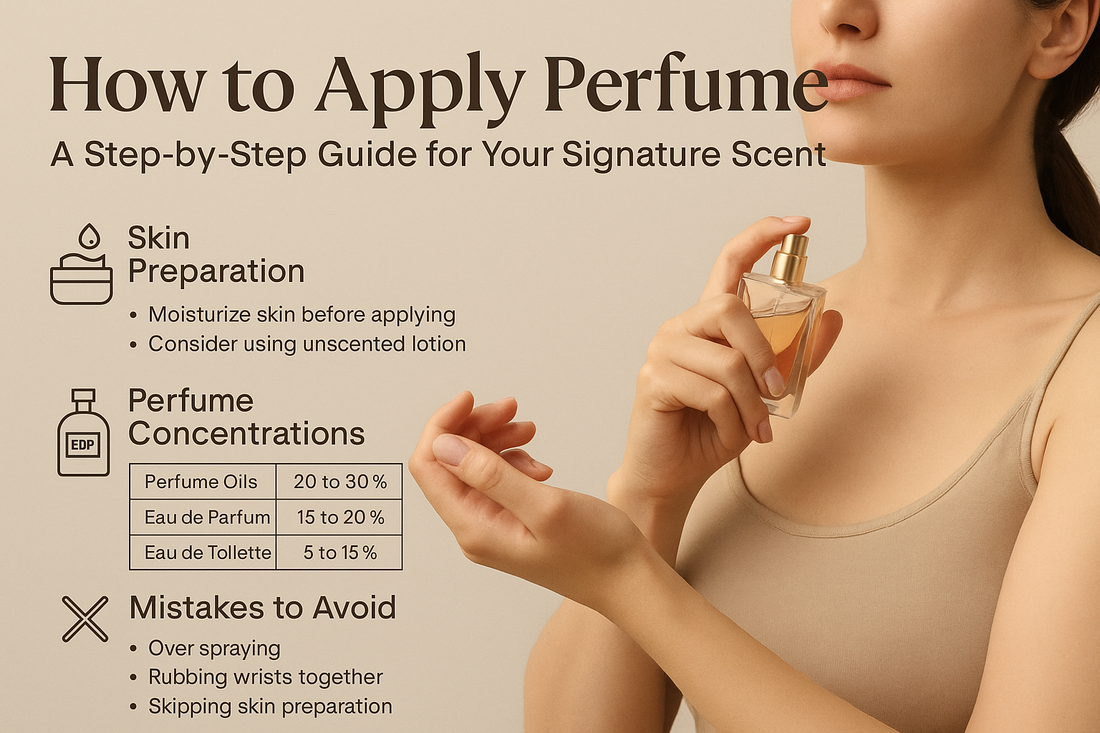
How to Apply Perfume: A Step-by-Step Guide for Your Signature Scent with Antibrnd Perfumes
Share
Creating a lasting impression with your favorite fragrance is more than simply spraying perfume and moving on. At Antibrnd Perfumes we believe the right technique turns each application into a memorable ritual. In this guide, you will discover professional tips on how to apply perfume so that your scent becomes uniquely yours.
Introduction
Many people fall into the common practice of misting perfume in the air and walking through it. That approach often leads to uneven coverage and wasted product. Below you will find practical tips on how to apply your favorite scent. A routine that begins with skin prep and ends with strategic placement lets each layer unfold naturally, highlights the top notes, and delivers a lasting aroma.
Skin Preparation: Your Canvas
Well-hydrated skin and the right base mean your fragrance lasts longer and smells truer. Follow these steps:
-
Dry your skin thoroughly after showering by gently patting with a towel.
-
While still slightly damp, moisturize your skin with an unscented or matching body lotion. This creates a smooth surface for your scent to cling to.
-
For extra hold, mix a drop of perfume oil into your lotion before rubbing it in. Those oils carry a higher concentration and help lock your fragrance into your skin.
When you prepare your skin this way, you give your perfume something to absorb into and prevent it from evaporating too quickly. Hydrated skin also supports the natural chemistry that makes your scent one of a kind.
Choosing the Right Concentration
Not all fragrances are built the same. Here is how to decide when to wear perfume and how often to reapply:
| Format | Oil Concentration | Ideal Use |
|---|---|---|
| Perfume Oils | 20 to 30 percent | Intimate evenings and layered application |
| Eau de Parfum | 15 to 20 percent | Special occasions and all day confidence |
| Eau de Toilette | 5 to 15 percent | Casual daytime and a light fresh effect |
Perfume oils have the highest concentration, delivering depth that lasts late into the night. Eau de parfum strikes a balance between rich base notes and airy middle notes. Eau de toilette focuses on top notes for a breezy first impression. In humid weather, a lighter format may feel more comfortable, while cooler days can handle a richer concentration.
Locating Pulse Points
Heat amplifies fragrance. Pulse points are areas where your blood vessels lie close to the skin surface. When you move, these spots release scent throughout the day. Key areas include:
-
Inner wrists
-
Base of the throat
-
Behind the ears
-
Inner elbow creases
-
Behind the knees
By focusing on pulse points, you create a soft cloud of scent that unfolds with your every gesture. If you rest an arm or turn your head, you will notice the fragrance evolve in layers.
Proper Application Technique
Instead of spraying perfume on your clothing or relying on wrists and then rubbing to spread it, allow each spray to settle naturally on your skin. Here is how:
-
Hold the bottle about six inches from your body.
-
Aim at each pulse point and apply fragrance with one confident spray.
-
Don’t rub the mist in because rubbing can break down delicate molecules and flatten how your fragrance develops.
A single precise spray at each point retains the integrity of your top notes, heart notes, and base notes.
Layering for Depth and Longevity
Layering your scented products takes your routine from ordinary to luxurious:
-
Begin with an unscented or lightly scented shower gel.
-
Follow with a matching body lotion or a neutral cream.
-
Spray your chosen perfume onto your prepared skin.
For an extra anchor, dab a small amount of perfume oil on dry spots such as the crook of your elbow before misting. This creates a nuanced bridge between top notes and base notes and makes your scent feel multidimensional.
Common Mistakes to Avoid
| Mistake | Impact |
|---|---|
| Over spraying | Uses more product than needed and can overwhelm those around you |
| Spraying clothes only | Perfume on your skin interacts with warmth to reveal full complexity |
| Skipping skin preparation | Dry skin allows scent to evaporate too quickly |
| Rubbing wrists together | Destroys top notes and shortens how long your scent lasts |
| Ignoring storage conditions | Sunlight and heat can break down perfume oils and alcohol base |
| Shaking the bottle vigorously | Introduces air that can alter the fragrance profile |
By avoiding these pitfalls you will get more from every bottle and enjoy a well balanced sillage.
Day-to-Night Routine
Morning at the office
Choose a light scent, such as an eau de toilette. Two sprays, one at the throat and one at a wrist, are usually enough to keep you feeling confident without overpowering your workspace.
Evening engagements
Switch to an eau de parfum for deeper character. Target your inner wrists, the base of your throat, and behind your ears to create a lasting impression.
Travel and quick refresh
Carry a small rollerball of your favorite fragrance. A discreet touch-up at pulse points keeps you smelling fresh without extra bulk.
Crafting Your Signature Scent
Your signature scent should feel like an extension of who you are. To find your personal blend:
-
Test complementary profiles at the counter using blotter strips.
-
Note how each scent evolves over two to three hours.
-
First apply the fragrance with the richer base, let it absorb then mist the lighter top.
Over time you will discover which combinations resonate with your mood, your style, and the memories you want to evoke.
Additional Tips on How to Apply
-
Store in a cool, dark place away from direct sunlight to preserve the integrity of perfume oils and alcohol blends.
-
Avoid spraying directly on jewelry or leather accessories to prevent staining.
-
If your skin tends to be dry, reapply body lotion more frequently to maintain a smooth, receptive surface.
-
Use a scented hair mist as a finishing touch so your hair carries a subtle aroma with every movement.
-
Decant a small amount into a travel-friendly container for on-the-go freshness.
Frequently Asked Questions
Q1: How often should I reapply my perfume?
A: It depends on concentration and climate. An eau de toilette may need a midday refresh, while an eau de parfum can last eight hours or more on moisturized skin.
Q2: Is it okay to spray perfume on clothes?
A: You can, but perfume on your skin interacts with body heat to fully reveal its complexity. On fabric it may smell muted or change color.
Q3: What makes perfume oils special?
A: Perfume oils contain fewer volatile compounds and a higher oil concentration. They linger longer and layer beautifully under your main fragrance.
Q4: What if I have sensitive skin?
A: Look for formulations labeled hypoallergenic, or apply your scent over clothing to reduce direct contact with alcohol and essential oils.
Q5: Can I mix brands when layering?
A: Yes, but test first on a blotter strip to ensure they harmonize rather than clash. A woody base with a floral top is often a winning combination.
Q6: Which less common pulse points can I try?
A: Your collarbone and the back of your knees are also effective. They release scent gently as your body moves.
Q7: How should I store my perfume long term?
A: Keep it in the original bottle in a cool, dark place such as a drawer. Avoid windowsills or the bathroom, where heat and humidity vary.
Q8: How many sprays count as one application?
A: One spray per pulse point is usually sufficient. For a more visible trail, you might add a third spray, but avoid layering too heavily.
Conclusion
Mastering these steps helps you transform a quick spray into an intentional ritual. By preparing your skin, selecting the right concentration, applying it at pulse points without rubbing, and layering wisely, you will elevate everyday application into a memorable signature scent moment. Trust this process and let Antibrnd Perfumes guide you to a fragrance experience that is unmistakably yours.
